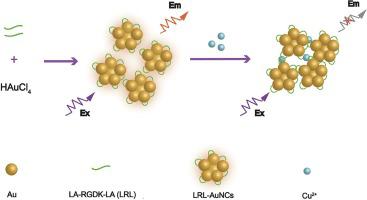Inorganic Chemistry Communications ( IF 3.8 ) Pub Date : 2021-01-21 , DOI: 10.1016/j.inoche.2021.108471 Di Qian , Zheng Wang , Zhongxin Xiao , Chen-Jie Fang

|
A fluorescent Au nanocluster LRL−AuNCs modified with RGDK-containing peptide was synthesized with a simple one-pot method. Based on the “turn-off” model, LRL−AuNCs displayed high sensitivity and selectivity for sensing Cu2+. It showed a good linear calibration between the fluorescence intensity and Cu2+ concentration in the range of 5 ~ 80 μM (R2 = 0.998), with the detection limit 3.9 μM. which is far lower than the maximum allowable concentration of Cu2+ (20 μM) in drinking water. Therefore, the detection of Cu2+ in water sample was performed in a handy way. As LRL−AuNCs showed low toxicity and good biocompatibility, LRL−AuNCs was used to sense the change of Cu2+ level in tumor cells by two-photon photoluminescence (TPPL) imaging. These results indicated that the LRL−AuNCs as a TPPL probe showed potential in tumor diagnosis and treatment.
中文翻译:

用于检测水和肿瘤细胞中Cu(II)的荧光探针
用简单的一锅法合成了用含RGDK的肽修饰的荧光金纳米簇LRL-AuNCs。基于“关闭”模型,LRL-AuNCs对感测Cu 2+具有很高的灵敏度和选择性。在5〜80μM(R 2 = 0.998)的范围内,荧光强度与Cu 2+浓度之间具有良好的线性校准,检出限为3.9μM。远低于饮用水中的最大允许浓度Cu 2+(20μM)。因此,以简便的方式进行了水样品中Cu 2+的检测。由于LRL-AuNCs具有低毒性和良好的生物相容性,因此LRL-AuNCs可用于检测Cu 2+的变化。双光子光致发光(TPPL)成像检测肿瘤细胞中的血红蛋白水平。这些结果表明,作为TPPL探针的LRL-AuNCs在肿瘤的诊断和治疗中具有潜力。



























 京公网安备 11010802027423号
京公网安备 11010802027423号